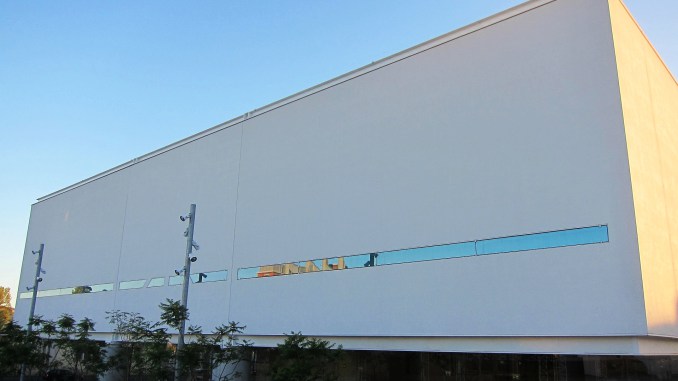by Theodore Dalrymple

Modernist architecture is inherently totalitarian: it brooks no other, and indeed delights to overwhelm and humiliate what went before it by size and prepotency, or by garishness and the preposterousness which it takes for originality, and which turns every townscape into the architectural equivalent of a Mickey Finn.
In the Guardian newspaper last week, its architectural correspondent wrote an admiring article about Paulo Mendes da Rocha, whose work is so bad that he has been awarded the Royal Institute of British Architects gold medal. No greater insult could well be imagined for an architect than that; and a small photograph accompanied the article, of a raw concrete sports club blackening horribly with age, as it always does, demonstrates that he well merited it.
The article begins by quoting the 88 year-old Brazilian: ‘All space is public. The only private space that you can imagine is in the human mind.’
The architectural correspondent, Oliver Wainwright seems to accept this dreadful dictum without comment or criticism, indeed appears to find it inspiring, though it is difficult to follow his thought processes:
It is an optimistic statement, given that he is a resident of São Paulo, a city where the triumph of the private realm over the public could not be more stark.
Why is the inherent, apparently ontological, impossibility of privacy something to be welcomed? Does Mr Wainwright defaecate and make love in public, and if not, does he want to? Besides, da Rocha didn’t way that all space ought to be public, he said it is public, it can be no other.
This kind of balderdash, of no possible denotation but with plenty of nasty connotation, is typical of writing about architecture, at least by apologists for modernism. It comes as no surprise to learn that da Rocha is a Marxist, though he could just as well be a fascist, as was his architectural ancestor, Le Corbusier.
Nowhere in the article is there an aesthetic judgment of the work of a man who ‘has spent his 60-year career lifting his massive concrete buildings up,’ which, by description, sound equally horrible and inhuman. This is a world in which the word brutalist can be used as a term of approbation. The nearest the writer comes to criticism is when he say that the architect’s unbelievably hideous building for the National Coach Museum in Lisbon near to ‘the gothic confection of the Jéronimos Monastery’ (note the disparagement) is that ‘it feels a little out of place – a great white aircraft hangar jacked up on fat concrete columns.’ He adds, ‘Still it might soften with time and use.’ It seems to have escaped this critic’s notice that concrete does not improve with time, and he does not explain how use can soften fat concrete columns.
First published in Salisbury Review.
- Like
- Digg
- Del
- Tumblr
- VKontakte
- Buffer
- Love This
- Odnoklassniki
- Meneame
- Blogger
- Amazon
- Yahoo Mail
- Gmail
- AOL
- Newsvine
- HackerNews
- Evernote
- MySpace
- Mail.ru
- Viadeo
- Line
- Comments
- Yummly
- SMS
- Viber
- Telegram
- Subscribe
- Skype
- Facebook Messenger
- Kakao
- LiveJournal
- Yammer
- Edgar
- Fintel
- Mix
- Instapaper
- Copy Link









3 Responses
It is an overgeneralisation to say that modernist architecture is inherently totalitarian. In some cases it may be but modernist architects such as Frank Lloyd Wrght and Eric Mendelssohn have created delightful buildings.
totalitarians often favour classicism eg Speer's plan for Berlin but one would not call classicism inherently totalitarian. Even though its source in classical Rome and Ancient Greece were hardly democracratic societies.
I seem to recall that the Gothic revival in Britain was partly due to a reaction against this view of classicism
Theodore Dalrymple happens to be one of the very few intelligent critics of the significance and destructive influence of modernist architecture and its contemporary offshoots. Yes, Wright and Mendelsohn ought to be treated separately for their own distinctive merits, yet they should not be used to confuse the main message.
Architecture in our time acts as a substitute religion, shaping and warping people's perception of natural order, with devastating consequences for culture and for the built environment. Let me refer readers to my own evaluation of contemporary architecture as a cult, re-printed as a Chapter in my book "Anti-architecture and Deconstruction".
Cordially,
Nikos Salingaros
Christopher Alexnder et al's book Pattern Language informed our (self and wife) plans when we remodelled the former commercial building we now live in. So I would probably be sympathetic to your views.
I am a (retired) neuropsychologist with an interest in the built environment going back to when I was a research assistant to Prof. Alice Coleman so I imagine I would find your work interesting.
I have read the sample chapters on your Unfied Archtectural Theory online amd will probably order one or both of your Amazon listed books.
I do find TD relentlessly gloomy. This may be a front for publication purposes however.